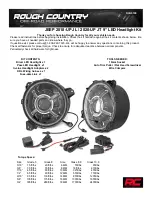
If you’ll be pulling a trailer that, when loaded, will weigh
more than 5,000 lbs (2 270 kg), be sure to use a
properly mounted weight-distributing hitch and sway
control of the proper size. This equipment is very
important for proper vehicle loading and good handling
when you’re driving. You should always use a sway
control if your trailer will weigh more than these limits.
You can ask a hitch dealer/retailer about sway controls.
Will you have to make any holes in the body of your
vehicle when you install a trailer hitch?
If you’re using the wiring provided with the
factory-installed trailering package, you should not need
to make any holes in the body of your vehicle.
However, if you have an aftermarket hitch installed, you
may need to make holes in the body.
If you do, then be sure to seal the holes later when you
remove the hitch. If you don’t seal them, deadly
carbon monoxide (CO) from your exhaust can get into
your vehicle as well as dirt and water. See “Carbon
Monoxide” under Engine Exhaust on page 2-31.
Safety Chains
You should always attach chains between your vehicle
and your trailer. Cross the safety chains under the
tongue of the trailer to help prevent the tongue from
contacting the road if it becomes separated from
the hitch. Instructions about safety chains may be
provided by the hitch manufacturer or by the trailer
manufacturer. Follow the manufacturer’s
recommendation for attaching safety chains and do not
attach them to the bumper. Always leave just enough
slack so you can turn with your rig. Never allow
safety chains to drag on the ground.
Trailer Brakes
If your trailer weighs more than 1,000 lbs (450 kg)
loaded, then it needs its own brakes – and they must be
adequate. Be sure to read and follow the instructions
for the trailer brakes so you’ll be able to install,
adjust and maintain them properly.
If your vehicle has StabiliTrak
®
, your trailer brake
system cannot tap into the vehicle’s hydraulic brake
system.
4-37
Summary of Contents for 2008 Express
Page 116: ... NOTES 2 36 ...
Page 119: ... NOTES 3 3 ...
Page 120: ...Instrument Panel Overview 3 4 ...
Page 364: ... NOTES 5 118 ...
















































